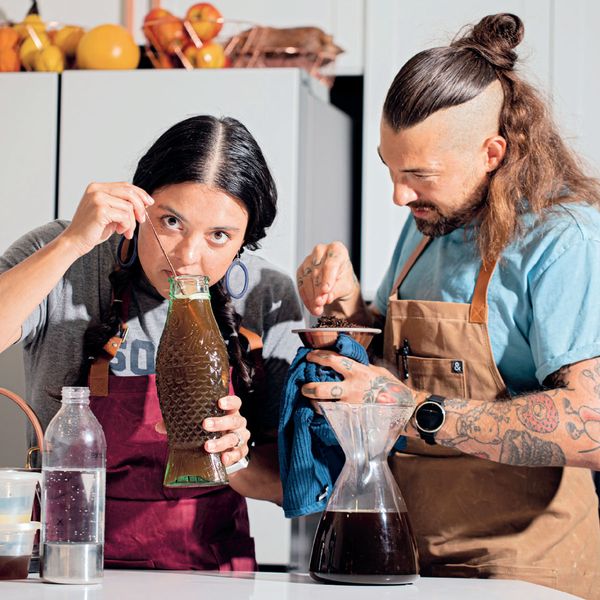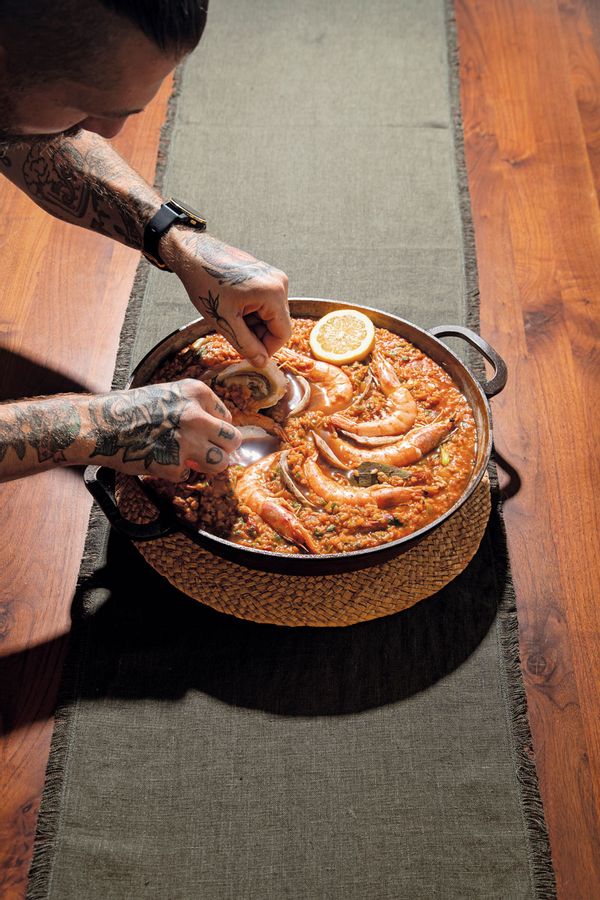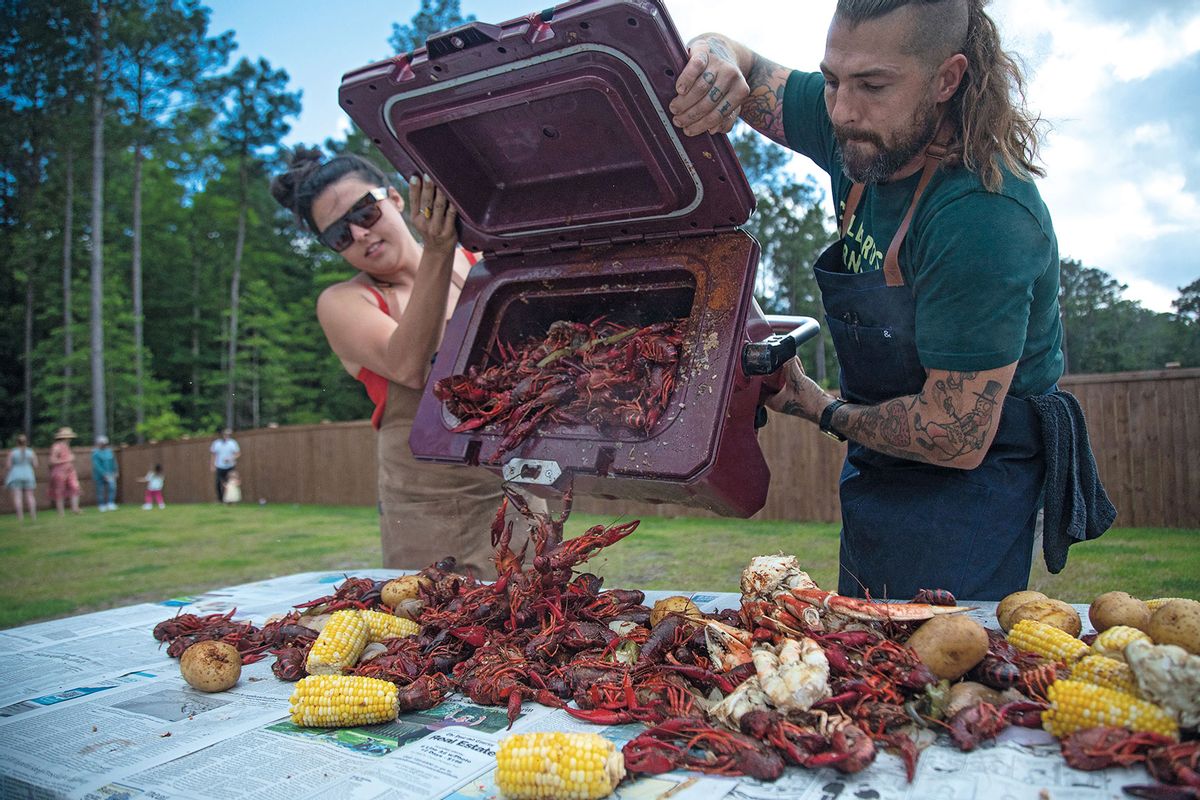Southern food can be mean something immensely different from person to person. For chef-restauranteur Sammy Wiggins and his wife, mixologist Kassady Wiggins, their focus is pulled towards the coasts.
The authors of a new cookbook “Salt & Shore: Recipes from the Coastal South” and owners of the restaurant Joyce in Los Angeles, the duo is passionate about highlighting the best that the coastal south has to offer, as well as prioritizing zero-waste cocktails and highlighting sustainability.
As they told me, “We wanted to create a culinary narrative that respects the past and looks forward to a sustainable future.”
With far-reaching intentions as well as unique ingredient usage, dishes intended for communal and convivial enjoyment and great recipes for cooks who aren’t especially well versed in the realm of fish, Monsour and Wiggins are excellent advocates not just for food and cooking at large, but also environmental rights, sustainability, fighting overfishing and the wonder of working with a spouse.
You can purchase Salt & Shore: Recipes from the Coastal South here.
Salt & Shore: Recipes From The Coastal South by Sammy Monsour and Kassady Wiggins (Weldon Owen / Simon & Schuster)
The following interview has been lightly edited for clarity and length.
I love how this book embodies precisely how it’s labeled: the perfect mix of “salt and shore,” both entirely Southern yet totally coastal-based. Can you explain a bit about the development of the book?
The development of “Salt and Shore” was a deeply collaborative and immersive experience. We aimed to capture the essence of Southern coastal cuisine by blending our personal experiences, various regional histories and contemporary culinary techniques. We hope while flipping through the pages, readers get a sense of our shared love for the ocean and the bounty it provides.
How would you define the ethos of “Salt and Shore?”
The ethos of “Salt and Shore” is about honoring the rich culinary traditions and history of the Southern coast while embracing sustainability and innovation. It’s a celebration of the diverse ingredients from the shorelines, the vibrant communities and the time-honored practices of Southern hospitality. We wanted to create a culinary narrative that respects the past and looks forward to a sustainable future.
Is “coastal southern” your general approach, from the cookbook to your restaurants to home cooking?
Yes, “coastal southern” is a central theme in our cookbook, restaurants and home cooking. It’s a cuisine that’s deeply rooted in the traditions of the South but is also heavily influenced by the coastal environment. This approach allows us to highlight fresh, locally sourced seafood and seasonal produce; creating dishes and drinks that are both comforting and contemporary. A central theme you’ll see throughout the cookbook is also recognizing the huge and ever-evolving impact other food cultures have had on “coastal southern” cuisine and (of course) in our very own home.
How do you think your backgrounds influenced your current food perspective, both personally and professionally?
Our backgrounds have significantly shaped our food perspective. Growing up in the South, we were both influenced by the region’s rich culinary heritage and the importance of community and hospitality. Sammy’s Lebanese roots inspire flavors and techniques in the kitchen, while Kassady’s African American heritage fuels her commitment to social justice and sustainability.
Professionally, our experiences in various kitchen/restaurant settings and our commitment to sustainability have driven us to create dishes and drinks that are not only delicious but also mindful of their environmental impact.
 Sammy Monsour and Kassady Wiggins (Photo courtesy of Ziv Sade and Sammy Monsour)
Sammy Monsour and Kassady Wiggins (Photo courtesy of Ziv Sade and Sammy Monsour)
I am so interested by the section in the book about algae and microalgae in drinks. I also saw chlorella in the Pawleys Island Palmer. Can you elaborate a bit on that?
Incorporating algae and microalgae into drinks is part of our commitment to sustainability and innovation. Chlorella in the Pawleys Island Palmer, for example, adds a unique flavor and a boost of nutrients. In the Blue Bayou, blue spirulina adds a depth of flavor unattainable by any other means. These ingredients not only offer health benefits but also reflect our connection to the ocean and our desire to use diverse, sustainable ingredients in creative ways.
“Fish Camp ”is so fun. I love the name of the chapters/categories and the convivial, social nature of those fish fries. Can you speak a bit to that?
The “Fish Camp” section is inspired by the traditional fish fries and social gatherings that are a staple in Southern culture. It’s about bringing people together to enjoy simple, delicious food in a convivial atmosphere. The name and the concept are meant to evoke a sense of nostalgia and community, celebrating the joy of shared, easy-going meals and good company.
I also enjoyed the “stock market” section, with such deeply flavorful, almost home-y dishes, from perloo to gumbo. I wonder if ostensibly more involved, storied dishes like that are sometimes intimidating for cooks? What are some tips you can give for people looking to cook those dishes?
While dishes like perloo and gumbo might seem intimidating, they are all about layering flavors and taking your time. Our tips for home cooks include starting with high-quality ingredients, following the steps carefully and not being afraid to make the recipe your own.
These dishes are meant to be comforting and home-y, so don’t stress about perfection—enjoy the process and the results. We want these dishes to taste (and feel) good to you at every step, much more than we want them to be “perfect.”
What do you think are some of the best ways for the most fish-averse cooks to get into the realm of fish cookery?
For those new to fish cookery, we recommend starting with some of the more iconic, approachable dishes from our “Hand Held” and “Fish Camp” chapters. These recipes are designed to be fun, social and relatively easy to prepare. Dishes like blackened fish tacos, our various fish “burgers,’ or our numerous styles of fish fry are great entry points. They offer familiar flavors and straightforward techniques that build confidence.
Plus, they capture the convivial spirit of coastal Southern cuisine, making the cooking experience enjoyable and rewarding.
How do you recommend reducing food waste for home cooks?
Reducing food waste at home involves planning meals, using leftovers creatively and composting scraps. We also encourage home cooks to embrace the whole ingredient, such as using fish bones for stock or vegetable peels for broths. Being mindful of portions and storage can also help minimize waste. There are quite a few tips on this in the “Libations” chapter—as syrups and ice are an easy way to mitigate a lot of what we think of as food waste.
You’re both advocates for environmental rights and sustainability in the kitchens. Can you speak a bit to that?
Our advocacy for environmental rights and sustainability is a core part of our culinary philosophy. In our professional kitchens (and home kitchen), we have always prioritized sourcing sustainably, minimizing waste and educating our team and customers about the importance of protecting our natural resources. We believe that every small effort counts towards a larger impact on the environment.
How can home cooks help mitigate environmental damages?
Home cooks can mitigate environmental damage by supporting local farmers and fishers, choosing sustainable ingredients and trying to reduce waste. Simple actions like composting, using reusable bags and containers and being mindful of water and energy use in the kitchen can make a significant difference.
 Charleston Perloo (Photo courtesy of Ziv Sade and Sammy Monsour)
Charleston Perloo (Photo courtesy of Ziv Sade and Sammy Monsour)
Is there a standout recipe for the both of you in the book?
A standout recipe for us is the Charleston Perloo, which also graces the cover of the book. This dish is a quintessential example of Southern coastal cuisine, combining rice, seafood and a rich, flavorful broth. It’s a celebration of the Lowcountry’s bounty and culinary traditions. The perloo embodies the heart and soul of “Salt and Shore,” blending simplicity with depth and history. It’s a dish that’s both comforting and elegant, perfect for showcasing the vibrant flavors and communal spirit of Southern coastal cooking.
The pecan salsa matcha with the grilled tilefish sounds stupendous! How did that component come together?
The pecan salsa macha is inspired by traditional Mexican salsa macha, which is known for its rich, nutty and spicy flavors. We wanted to bring a Southern twist to this classic by incorporating pecans, a staple in Southern cuisine. The combination of toasted nuts, dried chilies and aromatic spices creates a complex, robust sauce that perfectly complements the grilled tilefish.
This dish exemplifies our approach of blending diverse culinary traditions to create something uniquely Southern and coastal, while paying homage to the vibrant flavors of Mexican cuisine.
I love fish in all iterations, but do you think there’s a certain cooking methodology that lets the favor of the fish shine most? Raw? Grilled? Fried?
Each cooking method brings out different qualities in each species or variety of seafood. Raw preparations like ceviche highlight the freshness and natural flavors, while grilling adds a smoky depth. Frying offers a crispy texture that many enjoy. The best method depends on the type of seafood and the desired flavor profile, but ultimately, the simplest methods often let the seafood shine the most.
As with many a seafood cookbook, there are no desserts. Did you contemplate adding any or did you want to steer clear since there would (most likely) not be any actual fish in those dishes?
Instead of focusing on desserts, we dedicated an entire chapter to cocktails. We believe that a thoughtful libation sets the tone for the meal and it’s a Southern tradition to welcome guests with a cocktail. This approach aligns perfectly with Kassady’s specialty and her way of expressing creativity.
By emphasizing pre-dinner drinks, we provide a unique and engaging start to the culinary experience. While many cookbooks end with dessert, we chose to highlight the importance of the welcome libation, ensuring that every meal begins with a touch of Southern hospitality and sets the tone for the rest of the meal.
Can you speak a bit to the current state of overfishing?
Overfishing remains a significant global challenge, threatening marine ecosystems and the livelihoods of those who depend on them. However, it’s important to recognize and celebrate the progress made in the United States. Thanks to the science-based regulatory framework provided by the Magnuson-Stevens Act, we’ve been able to recover our overfished stocks and are now global leaders in wild fisheries management. This act ensures that our fisheries are managed sustainably, balancing environmental, economic and social objectives. It’s a testament to what can be achieved with robust regulations and dedicated conservation efforts and it offers a hopeful model for addressing overfishing worldwide.
Tell me a bit about your new LA restaurant, Joyce? The menu is amazing
Joyce is a celebration of elevated Southern coastal cuisine with a modern twist. The menu features a zero-landfill cocktail program, sustainably sourced seafood, locally grown produce and inventive dishes that honor tradition while pushing culinary boundaries. It’s a place where guests can enjoy the flavors of the coast in a welcoming, vibrant setting.
Want more great food writing and recipes? Subscribe to Salon Food’s newsletter, The Bite.
Could you explain what exactly a zero-landfill bar program is? Does it also offer non-alcoholic drinks?
A zero-landfill bar program means that we aim to produce no waste that ends up in landfills. This involves composting organic waste, recycling materials and using sustainable, reusable, or biodegradable products. We’ve developed creative ways to mitigate waste, finding secondary uses for produce that’s past its prime—whether bent, broken, bruised, blemished, or overly ripe. It also involves a lot of communication and cross-utilization with the kitchen. We try to mirror flavors on both sides of the menu.
Take, for example, our Mother of Pearl Martini—we roast the top shells of oysters and make a vodka infusion with them and we make an in-house vermouth with past-its-prime white wine, ogo algae (that you can also find on our Ogo Ceaser salad) and lemon peels that have been expressed for another cocktail garnish. Other ways in which we “close the loop” are through syrups, infusions, shrubs, tinctures and bitters.
Additionally, we offer a range of non-alcoholic drinks crafted with the same care and creativity as our cocktails, ensuring that all guests have delicious, eco-friendly options. This program reflects our commitment to sustainability and innovation, making every aspect of our bar as environmentally friendly as possible.
Could you both speak to the notion of working so closely with a spouse, both in terms of the book and the day-to-day in the restaurant?
Working closely with each other over the past eight years has been rewarding. It allows us to share our passion for food and sustainability, collaborate creatively and support one another. While it comes with its challenges, the key is communication, respect and finding a balance between our professional and personal lives.
 Sea Scallops (Photo courtesy of Ziv Sade and Sammy Monsour)
Sea Scallops (Photo courtesy of Ziv Sade and Sammy Monsour)
What is a formative cooking memory?
Sammy here. One of my most formative cooking memories is growing up with my Taita, my Lebanese grandmother, who was an amazing cook. She would prepare elaborate feasts featuring freshly made pita bread, stews, hand pies, rice dishes and pastries, all from our homeland where she was born and raised. Helping her make hand pies and spending time with her in the kitchen are some of my earliest, fondest memories. My family celebrates her life and legacy through her treasured recipes, which I cook often at home. It’s also Kassady’s favorite cuisine for me to cook for her at home. This connection to my Lebanese heritage through cooking allows me to honor my family’s traditions and care for my loved ones, keeping Taita’s spirit alive in every dish.
Both of our families talk about food before anything when getting together; everything is planned around food. Formative cooking memories for us involve helping our families prepare large, communal meals during holidays. These experiences instilled in us the importance of food in bringing people together and the joy of sharing a meal with loved ones. They also taught us the value of hard work, patience and the love that goes into cooking and ultimately nourishing one another.
Why do you cook?
We cook because it’s our way of expressing creativity, nourishing loved ones, connecting with others and honoring our heritage. It’s a form of art and a means of storytelling that allows us to share our passion for food and sustainability with the world. Cooking brings us joy and fulfillment and it’s our way of making a positive impact.
What are your top three favorite ingredients to work with?
Asking us to choose a favorite child? Broadly, our favorite ingredients to work with are unique spices, grass-fed butter, fresh seafood and seasonal produce. These elements allow us to create dishes that are vibrant, flavorful and reflective of the diverse culinary traditions we cherish.
How do the two of you handle menu development, linking the bar program and the food menu so intrinsically?
When developing our menus, we start with the seasonal and sustainable ingredients available to us, ensuring that both the food and beverage components highlight the best of what each season has to offer. We brainstorm dishes and cocktails that complement these ingredients while creating a harmonious and cohesive dining experience. Linking the bar program with the food menu involves crafting flavor profiles that enhance and balance each other, ensuring that every bite and sip is part of a unified culinary journey.
Our aspiration is to create food and beverages that are delicious, beautiful, crave-worthy and soul-satisfying. We believe that every element, from the welcome cocktail to the final dish, should contribute to an unforgettable dining experience. This holistic approach allows us to express our creativity fully and ensures that our guests enjoy a seamless and delightful blend of flavors and aesthetics.
Read more
about this topic
